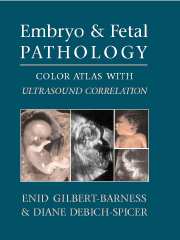Book contents
- Frontmatter
- Contents
- Foreword by John M. Opitz
- Preface
- Acknowledgments
- 1 The Human Embryo and Embryonic Growth Disorganization
- 2 Late Fetal Death, Stillbirth, and Neonatal Death
- 3 Fetal Autopsy
- 4 Ultrasound of Embryo and Fetus: General Principles
- 5 Abnormalities of Placenta
- 6 Chromosomal Abnormalities in the Embryo and Fetus
- 7 Terminology of Errors of Morphogenesis
- 8 Malformation Syndromes
- 9 Dysplasias
- 10 Disruptions and Amnion Rupture Sequence
- 11 Intrauterine Growth Retardation
- 12 Fetal Hydrops and Cystic Hygroma
- 13 Central Nervous System Defects
- 14 Craniofacial Defects
- 15 Skeletal Abnormalities
- 16 Cardiovascular System Defects
- 17 Respiratory System
- 18 Gastrointestinal Tract and Liver
- 19 Genito-Urinary System
- 20 Congenital Tumors
- 21 Fetal and Neonatal Skin Disorders
- 22 Intrauterine Infection
- 23 Multiple Gestations and Conjoined Twins
- 24 Metabolic Diseases
- Appendices
- Index
8 - Malformation Syndromes
Published online by Cambridge University Press: 23 February 2010
- Frontmatter
- Contents
- Foreword by John M. Opitz
- Preface
- Acknowledgments
- 1 The Human Embryo and Embryonic Growth Disorganization
- 2 Late Fetal Death, Stillbirth, and Neonatal Death
- 3 Fetal Autopsy
- 4 Ultrasound of Embryo and Fetus: General Principles
- 5 Abnormalities of Placenta
- 6 Chromosomal Abnormalities in the Embryo and Fetus
- 7 Terminology of Errors of Morphogenesis
- 8 Malformation Syndromes
- 9 Dysplasias
- 10 Disruptions and Amnion Rupture Sequence
- 11 Intrauterine Growth Retardation
- 12 Fetal Hydrops and Cystic Hygroma
- 13 Central Nervous System Defects
- 14 Craniofacial Defects
- 15 Skeletal Abnormalities
- 16 Cardiovascular System Defects
- 17 Respiratory System
- 18 Gastrointestinal Tract and Liver
- 19 Genito-Urinary System
- 20 Congenital Tumors
- 21 Fetal and Neonatal Skin Disorders
- 22 Intrauterine Infection
- 23 Multiple Gestations and Conjoined Twins
- 24 Metabolic Diseases
- Appendices
- Index
Summary
Syndromes are causally identified entities. The multiple manifestation of those with a syndrome reflect pleiotropy (Table 8.1 and Figure 8.1). In (genetic) syndromesthisphenomenonmost likely reflects the severalprimary and secondary effects of a disturbance of a specific molecular system required for normal development. Thus, in Smith-Lemli-Opitz (SLO) syndromemicroencephaly, cleft palate, cataracts, total anomalous pulmonary venous return, polysyndactyly, intersex genitalia, andHirschsprung anomaly all seem to represent the primary and secondary effects of disturbed sonic hedgehog (SHH) signaling during ontogeny. No structural component anomaly of any malformation syndrome is obligatory and no one component is pathognomonic of any syndrome. Malformation syndromes consist or two or more developmental field defects or a single major field defect and several minor anomalies.
Hanhart and Poland-Möbius Complexes
Hanhart anomaly usually includes severe limb defects of at least one hand or foot and frequently is associated with severe oral abnormalities (Figure 8.2). The form of the condition associated with cranial nerve palsy is called the Hanhart-Möbius complex. It appears to be sporadic.
Beckwith-Wiedemann Syndrome (BWS) (OMIM #130650)
BWS is a multigenic disorder caused by dysregulation of imprinted growth regulatory genes within the 11p15 region. The clinical features include macroglossia, omphalocele, postnatal somatic gigantism, and neonatal hypoglycemia (Figures 8.3 to 8.5 and Table 8.2). Mean birth weight is about 3,900 g, although prematurity occurs in about 25%. Eventually height and weight are above the 90th centile and most exhibit advanced bone age.
- Type
- Chapter
- Information
- Embryo and Fetal PathologyColor Atlas with Ultrasound Correlation, pp. 227 - 253Publisher: Cambridge University PressPrint publication year: 2004

